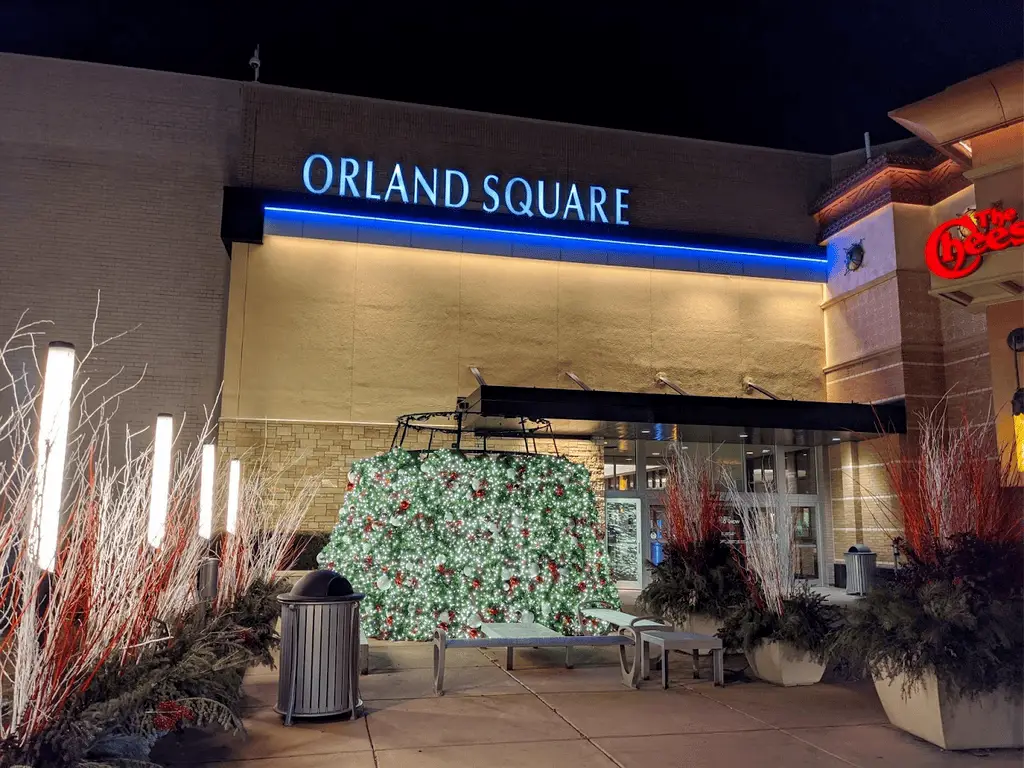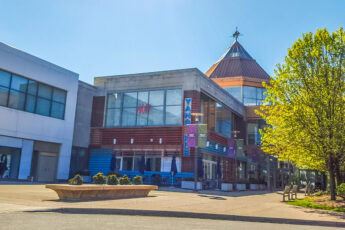Initial Development and Opening (1970s)
Orland Square Mall, located in Orland Park, Illinois, opened on March 15, 1976. Homart Development Company, a division of Sears, Roebuck & Co., developed the mall as a two-level shopping center.
The original anchor stores included JCPenney, Sears, Marshall Field’s, and Carson Pirie Scott. These stores established the mall as a retail hub, attracting customers from across the Chicago Southland.
The mall spanned over 1.2 million square feet and featured more than 100 retailers at its opening. The design focused on maximizing foot traffic, with wide corridors connecting anchor stores and mid-sized tenants.
Retailers such as B. Dalton Bookseller, Chess King, and Waldenbooks opened alongside the department stores, reflecting retail trends of the late 1970s.
Following the mall’s opening, the surrounding area of Orland Park saw rapid commercial and residential development.
Real estate development boomed as businesses sought proximity to the growing retail destination. Local infrastructure improvements followed, including expanded road access and public transportation links.
In its early years, Orland Square quickly became the primary shopping destination in the region. By the late 1970s, the mall drew customers not only from Orland Park but also from nearby suburbs like Tinley Park and Oak Forest.
The opening established Orland Square as a cornerstone of the local retail economy, shaping commercial growth in Orland Park and beyond. The mall remains a central attraction, featuring prominently in things to do in Orland Park, Illinois.
Major Expansions and Renovations (1980s-1990s)
In the mid-1990s, Orland Square Mall underwent a major renovation to update its aging infrastructure and enhance the shopping experience.
Completed in 1995, the project introduced modern finishes, new skylights, and redesigned entrances. Retailers took advantage of the updated spaces, and the mall attracted new tenants looking to capitalize on the improved environment.
One notable event before the renovation was the July 21, 1994, fire that destroyed the Buy The Weigh candy store.
While contained, this incident highlighted the need for facility upgrades and safety improvements. The renovation addressed these concerns, reinforcing the mall’s position as a dominant retail center.
During this time, the mall added popular chains like The Disney Store, Abercrombie & Fitch, and Victoria’s Secret, reflecting changing consumer preferences. The growing list of tenants emphasized the mall’s focus on fashion and specialty goods.
The expansion period also spurred new commercial developments around the mall. Restaurants and service businesses set up nearby, benefiting from the steady foot traffic. The increased activity further cemented Orland Square’s role as a commercial hub for Orland Park and surrounding suburbs.

Ownership Changes and Anchor Replacements (2000s-2010s)
The 2000s brought changes to the mall’s anchor lineup as ownership shifted. In 2006, Macy’s replaced the long-standing Marshall Field’s after Federated Department Stores acquired the brand.
This change reflected national trends and reinforced Macy’s presence in the Chicago market. Shoppers adapted to the new anchor, though the transition marked the end of an era.
In 2012, the mall underwent a comprehensive renovation that revamped entrances, improved lighting, and updated the food court layout.
The focus was on making the mall more inviting while enhancing the customer experience. This overhaul attracted both new retailers and returning customers, helping the mall stay competitive.
New entertainment options began to emerge during this period. Dave & Buster’s opened in 2012 as a stand-alone attraction in the mall’s parking lot, catering to families and groups looking for more than just shopping.
By December 2012, The Cheesecake Factory opened on the lower level near Macy’s, providing a popular dining option for both visitors and locals.
Gap, a retail staple, joined the Sears wing in early 2013, drawing steady foot traffic. Orland Square Mall also diversified by integrating more non-traditional retail spaces.
On November 4, 2016, Gizmo’s Fun Factory and Sky Zone Trampoline Park launched next to the former Carson’s Furniture Gallery, offering a mix of entertainment services not typically found in shopping malls.
In 2018, Sears, a founding anchor, closed its doors as part of the company’s broader financial struggles. The departure opened up 194,000 square feet of retail space.
Simon Property Group, which had acquired the mall’s ownership, redeveloped the area, opting to repurpose it rather than leave it vacant. Cubework, a coworking space provider, eventually bought it in 2023, reflecting shifts in commercial real estate use.
Around the same time, Carson Pirie Scott closed its location in April 2018, further signaling the decline of traditional department stores.
Von Maur took over the space, launching in November 2019 with a focus on upscale fashion and customer service. This move highlighted the mall’s ability to pivot and attract new high-end retailers, keeping the space relevant.
In January 2019, a shooting inside the mall led to the death of one person and injured another. The incident took place near the food court and prompted a swift response from local law enforcement.
The event raised questions about mall security and led to a reevaluation of safety measures, including increased patrols and more visible surveillance.

Cubework Purchased the Former Sears Property in Orland Square Mall
In 2023, a California-based company announced the acquisition of the former Sears property at Orland Square Mall. The purchase covers the 16-acre area, which includes approximately 100,000 square feet of space formerly occupied by Sears and a large adjacent parking lot.
Cubework intends to transform the space into a coworking mall, a relatively new concept focused on offering versatile rental spaces for businesses of varying sizes.
The company specializes in providing short-term and month-to-month leases, which include utilities and Wi-Fi, making the space attractive to small businesses and startups.
The company is known for its flexible rental options and a wide range of space configurations. These include dedicated cubicles, hot desks, private offices, and even specialized areas like maker spaces, wellness suites, and e-commerce fulfillment hubs. Cubework operates more than 50 such locations across the U.S.
Cubework’s purchase of the former Sears property at Orland Square Mall signals a trend toward repurposing large, vacant retail spaces for flexible coworking and mixed-use purposes.
This approach revitalizes underutilized properties and meets the growing demand for adaptable business spaces that cater to diverse entrepreneurial needs.








